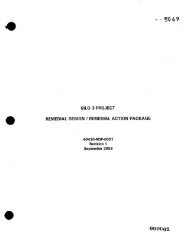closure project manager - Document Request - U.S. Department of ...
closure project manager - Document Request - U.S. Department of ...
closure project manager - Document Request - U.S. Department of ...
Create successful ePaper yourself
Turn your PDF publications into a flip-book with our unique Google optimized e-Paper software.
Each plenum has two systems, an automatic deluge system at the particle impingement<br />
separation screens (demister screen) and a manually activated deluge system upstream <strong>of</strong> the<br />
first stage <strong>of</strong> HEPA filters. The Building 991 ro<strong>of</strong> plenum only has one stage <strong>of</strong> HEPA filters<br />
while the Building 985 plenum has two stages <strong>of</strong> HEPAs.<br />
The demister chambers for the Building 991 ro<strong>of</strong> plenum and Building 985 are shown in<br />
Figures 2-13 and 2-14. These chambers have nozzles located approximately six inches upstream<br />
<strong>of</strong> the demister screen. The spray pattern is designed so that a water curtain is discharged to cool<br />
the incoming air. The spray may also facilitate particulate removal. The capabilitv to observe<br />
spray oatterns <strong>of</strong> the automatic portion <strong>of</strong> the deluge svstem in the Building 991 ro<strong>of</strong> plenum is<br />
significantly impaired due tu the close prorcimih7 <strong>of</strong> the filter stage to the plenum wall. That is,<br />
the inlet plenum wall is verv close to the filter stage blocking view <strong>of</strong> some <strong>of</strong> the spray nozzles<br />
due to limitations <strong>of</strong> .line <strong>of</strong> sight. Also. nozzle smass near observation ports degrade the<br />
visibilitv <strong>of</strong> the spray for nozzles further awav from the observation port. The automatic plenum<br />
deluge systems are defense-in-deDth systems and are nut credited controls in the safe@ analysis.<br />
The adecluacv <strong>of</strong> this confirnation for a credited safetv system would be questionable since<br />
nozzle sprav patterns for some portions <strong>of</strong>the plenum may not mitigate high air temperature or<br />
hot ember and flvinp brand impacts on iilters (i.e.. certain areas <strong>of</strong> the filter stage may not be<br />
cooled or protected against hot particulates). Heat detectors located in the inlet ducts to the filter<br />
plenum actuate the automatic deluge valves. When high temperature air passes over the heat<br />
detector, the contacts within the detector .change state at 190°F, which sends a signal to the<br />
associated deluge control panel. The deluge control panel for the Building 991 ro<strong>of</strong> plenum is<br />
located in Room 130 and the panel for the Building 985 plenum deluge system is located in<br />
Building 985. The deluge control panel simultaneously sends an alarm to the CAS and FDC (via<br />
the Signal Input / Output (SIO) panel), sends an alarm to the deluge control panel, and sends a<br />
signal to the solenoid that opens the automatic deluge valve. The deluge control panels have<br />
batteries that provide backup power to the panel if alternating current (AC) power is lost. The<br />
circuitry is supervised. A supervisory alarm is received at the FDC when AC or direct current<br />
(DC) power is lost. The demister screens remove much <strong>of</strong> the water from the air stream before<br />
it reaches the HEPA filters to protect the filtration capability <strong>of</strong> the filters.<br />
The manually activated deluge system is located immediately upstream <strong>of</strong> the frrst stage<br />
<strong>of</strong> HEPA filters. Deluge nozzles spray water directly onto the first stage <strong>of</strong> KEPA filters. The<br />
manual deluge system provides an important emergency capability if the frrst stage <strong>of</strong> HEPA<br />
filters is in danger <strong>of</strong> being consumed by fire. Activation <strong>of</strong> the system under such conditions,<br />
however, will likely result in the loss <strong>of</strong> the first stage, either due to plugging by soaked<br />
particulates (which will effectively stop ventilation), by partial plugging causing media failure,<br />
or by direct damage. Failure <strong>of</strong> the first stage other than by plugging will subject remaining<br />
downstream stages to the possibility <strong>of</strong> fire, heat, or physical damage.<br />
The hazard and accident analysis credits the filtered exhaust ventilation svsterns in<br />
Building 991 and 3uildina 985. The automztic pieiium deluge swteems are identified as<br />
defense-in-depth systems for the filtered exhaust vendlation svsterns but are not credited in the<br />
safetv analys&. The systems are to be maintained in their current configuration (i.e., not allowed<br />
to dewade an17 fhrther than is currently realized) as added assurance for motection <strong>of</strong> the HEPA<br />
Revision I Building 991 Complex FSAR<br />
September 1999<br />
I
















